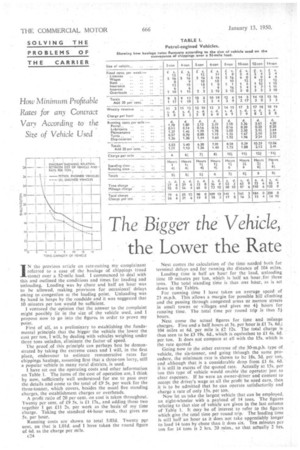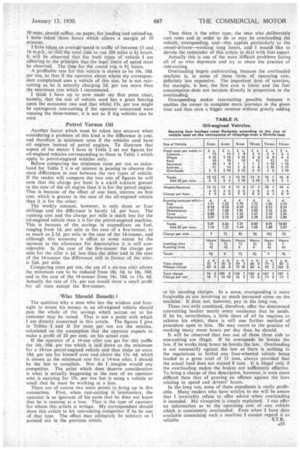The Bigger the Vehicle, the Lower the Rate
Page 62

Page 67

If you've noticed an error in this article please click here to report it so we can fix it.
IN the previous article on rate-cutting my complainant referred to a case of the haulage of chippings (road stone) over a 52-mile lead. I commenced to deal with this and outlined the conditions and times for loading and unloading. Loading was by chute and half an hour was to be allowed, making provision for occasional' delays owing to congestion at the loading point. Unloading was by hand in heaps by the roadside and it was suggested that 10 minutes per ton would be sufficient.
I ventured the opinion that the answer to the complaint might possibly lie in the size of the vehicle used, and I propose now to go into the figures in order to prove my point.
First of all, as a preliminary to establishing the fundamental principle that the bigger the vehicle the lower the cost per ton, I will, by dealing with vehicles weighing under three tons unladen, eliminate the factor of speed.
The proof .of this principle can perhaps best be demonstrated by taking the extreme cases and I will, in the first place, endeavour to estimate remunerative rates for chippings haulage, assuming first that a three-ton lorry, still a popular vehicle in many rural districts, is used.
I have set out the operating costs and other information on Table 1. The items of the cost of operation are, I think by now, sufficiently well understood for me to pass over the details and come to the total of £9 5s. per week for the three-tonner, which covers. besides the usual five standing charges, the establishment charges or overheads.
A profit ratio of 20 per cent on cost is taken throughout. Twenty per cent. of £9 5s. is fl 17s., and adding those two together I get £11 2s. per week as the basis of my time charge. Taking the standard 44-hour week, that gives me 5s. per hour.
Running costs are shown to total 5.03d. Twenty per cent. on that is 1.01d. and I have taken the round figure of 6d. as the charge per mile.
(224 Next comes the calculation of the time needed both for terminal delays and for running the distance of 104 miles.
Loading time is half an hour for the load, unloading time 10 minutes per ton, which is half an hour .for three Ions. The total standing tithe is thus one Mar, as is set down in the Tables.
For running time I have taken an average speed of 23 m.p.h. This allows a margin for possible hill climbing and the passing through congested areas or narrow streets in small towns or villages and gives me 4i hours for running time, The total time per round trip is thus hou rs.
Next come the actual figures for time and mileage charges. Five and a half hours at 5s. per hour is II 7s. 6d.; 104 miles at 6d. per mile is 12 12s. The total charge is thus seen to be £3 19s. 6d., which is equivalent to £1 6s. 6d. per ton. It does not compare at all with the 15s, which is the rate quoted. • Going now to the Other extreme of the 30-m.p.h. type of vehicle, the six-tonner, and going through the same procedure, the minimum rate is shown to be 18s. 3d. per ton, and although that is a considerable drop from £1 6s. 6d. it is still in excess of the quoted rate. Actually at 15s. per ton this type of vehicle would enable the operator just to clear expenses. If he were an owner-driver and content to accept the driver's wage as all the profit he need earn, then it is to be admitted that he can operate satisfactorily and charge a rate of only 15s. per ton. Now let us take the largest vehicle that can be employed, an eight-wheeler with a payload of 14 tons. The figures relating to that size of vehicle are given in the last column of Table I. It may be of interest to refer to the figures which give the total time per round trip. The loading time is still half an hour as it does not take appreciably longer to load 14 tons by chute than it does six. Ten minutes per ton for 14 tons is 2 hrs. 20 mins., so that actually 2 hrs. 50 mins, should suffice, on paper, for loading and unloading. I have taken three hours which allows a margin of 10 minutes.
I have taken an average'speed in traffic of between 15 and 16 m.p.h., so that the total time to run 104 miles is 6,1 hours. It will be observed that for both types of vehicle I am adhering to the principle that the legal limits of speed must be observed. The time for the round trip is 9i hours.
A. profitable rate for this vehicle is shown to be I4s. 1041. per ton, so that if the operator about whom my correspondent complained uses a vehicle of this size, he is not ratecutting as he is actually charging 2d. per ton more than the minimum rate which I recommend.
I think I have up to now made my first point clear, namely, that the size of vehicle used has a great bearing upon the economic rate and that whilst 15s. per ton might be outrageous rate-cutting if the operator concerned were running the three-tonner, it is not so if big vehicles can be used.
Petrol Versus Oil
Another factor which must be taken into accorgit when considering a problem of this kind is the difference in cost, and therefore in minimum rates if the vehicles used have oil engines instead of petrol engines. To illustrate that aspect of the matter I have in Table 2 set out figures for oil-engined vehicles corresponding to those in Table 1 which • apply to petrol-engined vehicles only.
Before comparing the minimum rates per ton as calculated for Table 2 it is of interest in passing to observe the main differences in cost between the two types of vehicle. If the reader will compare the two sets of figures he will note that the charge per hour is a small amount greater in the case of the oil engine than it is for the petrol engine. That is because of the effect of one item, interest on first cost, which is greater in the case of the oil-engined vehicle than it is for the other.
The weekly amount, however, is only three or four shillings and the difference is barely Id. per hour. The running cost and the charge per mile is much less for the oil-engined vehicle than it is for the petrol-engined machine. This is because of the savings in expenditure on fuel, ranging from Id. per mile in the case of a five-tonner, to as much as 2.14. per mile in the case of the 14-tonner, and although this economy is offset to some extent by the increase in the allowance for depreciation it is still considerable. In the case of the five-tonner the charge per mile for the oiler is i-d. less than the other and in the case of the 14-tonner the difference, still in favour of the oiler, is 20. per mile.
Comparing rates per ton, the use of a six-ton oiler allows the minimum rate to be reduced from 18s. 3d. to 16s, 104. and in the case of the 14-tonner from 14s. 10d. to 13s. 64. Actually the rate of 15s. per ton would show a small profit for all sizes except the five-tonner.
Who Should Benefit ?
The question why a man who has the wisdom and foresight to invest his money in an oil-engined vehicle should pass the whole of the savings which accrue on to his customer may be raised. That is not a point with which I am directly concerned in this article. The figures I give in Tables I and II for rates per ton are the minima, calculated on the assumption that the operator expects to make a profit of 20 per cent, on his actual cost.
If the operator of a 14-ton oiler can get for this traffic the 14s, 10d. per ton which is laid down as the minimum for a 14-ton petrol-engined vehicle and thus make an extra 18d. per ton for himself over and above the 13s. 41:1. which is shown as the minimum rate for a 14-ton oiler, I should be the last to complain. Nor do I imagine would any competitor. The point which does deserve consideration is what is actually happeningin the case of an operator who is carrying for 15s. per ton but is using a vehicle so small that he must be working at a hiss.
There are of course two main points to bring up in this connection. First, when rate-cutting is involuntary, the operator is so ignorant of his costs that he does not know that he is running at a loss. That is the type of operator for whom this article is written. My correspondent should show this article to his rate-cutting competitor if he be one of that type. The effect may ultimately be salutary as pointed out in the previous article. Then there is the other type, the man who deliberately cuts rates and irt order to do so may be overloading the vehicle, 'overspeeding, and-this applies particularly to the owner-drivers-working long hours, and I would like to devote the remainder of this article to, deal with that aspect.
Actually this is one of the most diffictilt problems facing all of us who deprecate and try to abate the practice of rate-cutting.
Overloading begets undercutting, because the overloaded machine is, in some of these items of operating cost, definitely less expensive. The important item of taxation, for example, is less; the first cost is lower and the fuel consumption does not increase directly in proportion to the overloading.
Overspeecling makes rate-cutting possible because it enables the owner to complete more journeys in the given time and thus earn a bigger revenue without greatly adding
to his standing charges. In a sense, overspending is more forgivable as not involving so much increased stress on the machine. It does not, however, pay in the long run.
These two evils combined, therefore, offer the determined rate-cutting haulier nearly every assistance that he needs. If he be, nevertheless, a little short of all he requires to achieve his object,. there is still one further method of procedure open to him. He may resort to the practice of working many more hours per day than he should.
It will be observed that two out of these three aids to rate-cutting are illegal. If he overspeeds he breaks tile law, if he works long hours he breaks the law. Overloading is not necessarily against the law as there is .nothing in the regulations to forbid any four-wheeled vehicle being loaded to a gross total of 12 tons, always provided that the actual load does not exceed 8 tons. It is illegal only if the overloading makes the brakes not sufficiently effective. To bring a charge of that description, however, is even more difficult than that of proving art offence against the laws relating to speed and drivers' hours.
In the long run, none of these expedients is really profitable. Many readers who have written to me will be aware that I invariably refuse to offer advice when overloading is intended. My viewpoint is simply explained. I can offer no information as to the operating cost of any vehicle which is consistently overloaded. Even when I have data available concerning such a machine I cannot regard it as
reliable. S,T.R.




































































































